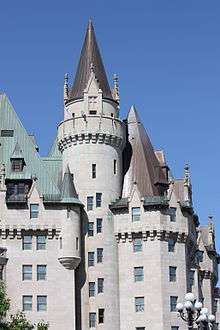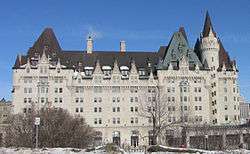Château Laurier
| Fairmont Château Laurier | |
|---|---|
|
Château Laurier seen from Parliament Hill | |
| General information | |
| Location |
1 Rideau Street Ottawa, Ontario, Canada K1N 8S7 |
| Opening | 12 June 1912 |
| Owner | Capital Hotel Limited Partnership[1] |
| Management | Fairmont Hotels and Resorts |
| Design and construction | |
| Architect |
Bradford Gilbert, Ross and Macfarlane |
| Other information | |
| Number of rooms | 429 |
| Website | |
| Official name | Château Laurier National Historic Site of Canada |
| Designated | 1981 |
The Fairmont Château Laurier is a 660,000-square-foot hotel with 429 guest rooms in downtown Ottawa, Ontario, located near the intersection of Rideau Street and Sussex Drive and designed in the French Gothic Châteauesque style to complement the adjacent Parliament buildings. The hotel is above the Rideau Canal locks and overlooks the Ottawa River. The main dining room (now the Laurier Room) overlooks Major’s Hill Park. The reception rooms include the Wedgewood-blue Adam Room; the Laurier Room defined by Roman columns; the Empire-style ballroom and the Drawing Room featuring cream and gold plaster ornament. The hotel was designated a national historic site in 1980.[2]
History
Grand Trunk Railway 1909–1923
Château Laurier was commissioned by Grand Trunk Railway president Charles Melville Hays, and was constructed for $2 million, between 1909 and 1912 in tandem with Ottawa's downtown Union Station (now the Government Conference Centre) across the street. The two buildings were connected with a tunnel. When the hotel first opened, private rooms cost $2 a night; 155 of the 350 bedrooms featured a private bath while the other 104 rooms had washstands with hot and cold water connections. In addition dormitories and common bathrooms were available as were rooms for travelling salesmen with sample tables to display goods.[2]
The hotel features original Tiffany stained-glass windows and hand-moulded plaster decorations dating back to 1912. The walls were constructed of Indiana limestone. There are conical turrets and dormer windows and the roof is copper. The gables are carved with flowers, scrolls and crests. The lobby floors were constructed of Belgian marble .[2]
The plans for the hotel initially generated some controversy, as the Château was to be constructed on what was then a portion of Major's Hill Park. Sir Wilfrid Laurier, then the Prime Minister of Canada, helped secure the important site for the construction, and the hotel was eventually named in his honour. Laurier's government was also subsidizing the Grand Trunk Railway's Pacific Line.[3] Further conflict ensued when the original architect, Bradford Gilbert, from New York was dismissed due to disagreements with Grand Trunk executives, and the Montreal firm of Ross and Macfarlane was hired to complete the design.[3] The hotel’s architects were from the Montreal firm Ross and MacFarlane.[2]
The hotel was to be opened on 26 April 1912, but Hays, who was returning to Canada for the hotel opening, perished aboard the RMS Titanic when it sank on 15 April.[4] A subdued opening ceremony was held on 12 June 1912, with Sir Wilfrid Laurier in attendance. The sub-basement housed laundry, repair shops, engineering and electrical departments. A barber shop was added in 1918.[2]
In August 1914, Major Raymond Brutinel enrolled the first recruits for the Canadian Automobile Machine Gun Brigade in the Château Laurier Hotel in Ottawa, Ontario. A memorial plaque with a circular "bas relief" of Brigadier-General Brutinel bust, and a "bas relief" of machine gunners on Vimy ridge are dedicated to the memory of Brigadier-General R. Brutinel, C.B. C.M.G. D.S.O. who commanded the Canadian Automobile Machine Gun Brigade and the members of the Canadian Machine Gun Brigade who died on active service and in honour of those who served.[5]
Canadian National Railway 1923–1988
When the Grand Trunk became part of the Canadian National Railway in 1923, the Château Laurier became one of CN's most important hotels. In addition to hotel guests, the Château Laurier has also served over the years as the home of two important Ottawa institutions. From July 1924 to October 2004, the seventh and eight floors at the top were home to the Canadian Broadcasting Corporation's local English and French language radio stations. Photographer Yousuf Karsh maintained his studio and residence at the Château Laurier for many years.[2]
In 1929, a $6-million east wing addition by Montreal architect John Archibald and CN’s architect John Schofield along Mackenzie Avenue added 240 rooms. Although the exterior of the addition was French-inspired, the interior lobby resembled an English or Scottish baronial hall with dark-oak panelling, a railed gallery overlooking the double-height space and trophies of the hunt. The lobby led to a convention hall, music room and gentlemen’s lounge. The ballroom featured vaulted ceiling, columns and rich drapes. The ultra-modern kitchen was designed to cater to up to 5,000 people. The Jasper Tea Room designed by Edwin Holgate in 1929, featured Pacific Coast aboriginal art, columns carved into totem poles surrounding a dance floor, and lamps decorated with motifs of bears, eagles and crows. From 1929–1991, the Canadian Grill was a softly-lit and dark-panelled below-ground restaurant where diners ate the specialty, roast prime rib of beef au jus and danced to live music.[2]
In 1930, the hotel added a 60-foot indoor pool in Art Deco style. In the 1930s and 1940s, the “therapeutic” spas offered electric therapy, ultra-violet ray lamps and alternate streams of hot and cold water to clients with nervous afflictions, polio or back problems.[2]
For years, the hotel thrived, playing host to royalty, heads of state, political figures, celebrities and members of Canada's elite. R.B. Bennett lived in a suite in the hotel during his term as Canadian prime minister, from 1930 to 1935.[6]

During the 1960s and 1970s, the construction of numerous competing hotels in the capital, as well as the closure of Union Station, led to a slow decline in the Château's fortunes.
In 1965, the Jasper Lounge, was redecorated into a mock English tavern called the Cock and Lion with oak and old brick walls. The union went to court to protest management's decision to replace waiters with young women in low-cut tops to serve in the new pub, but lost.[2]
In 1981, the hotel was designated a National Historic Site of Canada.[7] The Westin Hotel opened across the street in 1983. A $21-million renovation was undertaken in the 1980s to refurbish and renovate the Château Laurier, however, thus restoring its position as Ottawa's pre-eminent hotel. A new canopied front entrance was added. The lobby’s dark wood was lightened and the animal trophies were removed. The barber shop was removed. The fourth floor featured a separate lounge and concierge desk. The smoke shop became the Reading Room. The Cock and Lion lounge was replaced a skylit boutique mall. In 1985, Zoe’s Lounge opened in a new glassed-in area overlooking Rideau Street.
By 1991, Peacock Alley, which was broad corridor on the main level that extended along the west side of hotel was replaced by Wilfrid’s, featuring views of the Parliament Buildings, the Rideau Canal locks and the Ottawa River.[2]
Canadian Pacific Hotels 1988–1999
The hotel was operated by Canadian National Hotels until the chain was purchased by Canadian Pacific Hotels in 1988.
Fairmont Hotels and Resorts 1999–
In 1999, it was renamed the Fairmont Château Laurier after Canadian Pacific Hotels bought the American Fairmont hotel chain and changed its name to Fairmont Hotels and Resorts.
The new look was provided by Wilfrid’s on the main level, its big windows giving light and views of the Parliament Buildings, the Rideau Canal locks and the Ottawa River.
The hotel is just metres away from some of the capital's most important landmarks including Parliament Hill, the Rideau Canal, the National Gallery of Canada, the Byward Market, the National War Memorial, the U.S. Embassy, and the CF Rideau Centre. Given its proximity to these buildings and the fact that it has served as a home and meeting place for many notable political figures over the years, the hotel has often been referred to as "the third chamber of Parliament".
The hotel was the inspiration for the "Hotel du Canada" at the Canada (Epcot) pavilion in Orlando, Florida. In 2000, the Royal Architectural Institute of Canada chose the building as one of the top 500 buildings produced in Canada during the last millennium.[8]
Coinciding with its 100th anniversary, Fairmont Château Laurier was included amongst other architecturally interesting and historically significant buildings in Doors Open Ottawa, held June 2 and 3, 2012.[9]

See also
- Russell House (Ottawa) - the Château Laurier succeeded the Russell as Ottawa's premier hotel
- List of designated heritage properties in Ottawa
| Ottawa portal |
References
- ↑ http://www.cbc.ca/news/canada/ottawa/ottawa-s-iconic-fairmont-ch%C3%A2teau-laurier-hotel-sold-1.2335695
- 1 2 3 4 5 6 7 8 9 10 An elegant palace, but not just for the city’s elite, Maria Cook, The Ottawa Citizen
- 1 2 Kalman, 28.
- ↑ Fleury, Maureen K. Haunted Château Laurier Hotel, Ottawa, 2008.
- ↑ "Raymond Brutinel plaque". National Inventory of Military Memorials. National Defence Canada. 2008-04-16.
- ↑ Mr. Prime Minister 1867-1964, by Bruce Hutchison, Toronto 1964, Longmans Canada.
- ↑ Château Laurier National Historic Site of Canada. Canadian Register of Historic Places. Retrieved 8 November 2013.
- ↑ Cook, Marcia (11 May 2000). "Cultural consequence". Ottawa Citizen (Canwest). Retrieved 2009-10-11.
- ↑ http://ottawa.ca/doorsopen Doors Open Ottawa
- Bibliography
- Chisholm, Barbara, ed., Castles of the North: Canada's Grand Hotels, Toronto: Lynx Images, 2001.
- Fletcher, Katharine. Capital Walks: Walking Tours of Ottawa, Markham, Ontario: Fitzhenry & Whiteside, 2004.
- Fleury, K. Maureen. "Haunted Château Laurier Hotel, Ottawa", Jan 8. 2008
- Kalman, Harold and John Roaf. Exploring Ottawa: An Architectural Guide to the Nation's Capital. Toronto: University of Toronto Press, 1983.
- Local Architectural Conservation Advisory Committee of Ottawa, Ottawa: A Guide to Heritage Structures, Ottawa: LACAC, City of Ottawa, 2000.
- Rankin, Joan E., Meet Me at the Château: A Legacy of Memory, Toronto: Natural Heritage Books, 1990.
External links
| Wikimedia Commons has media related to Château Laurier. |
| ||||||||||||||||||||||||||||||||||||||||||
| ||||||||||
| ||||||||||||||||||
Coordinates: 45°25′32.04″N 75°41′42.39″W / 45.4255667°N 75.6951083°W
